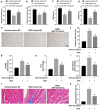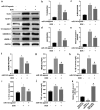Circ-0006332 stimulates cardiomyocyte pyroptosis via the miR-143/TLR2 axis to promote doxorubicin-induced cardiac damage
- PMID: 39018487
- PMCID: PMC11259061
- DOI: 10.1080/15592294.2024.2380145
Circ-0006332 stimulates cardiomyocyte pyroptosis via the miR-143/TLR2 axis to promote doxorubicin-induced cardiac damage
Abstract
Doxorubicin (DOX)-mediated cardiotoxicity can impair the clinical efficacy of chemotherapy, leading to heart failure (HF). Given the importance of circRNAs and miRNAs in HF, this paper intended to delineate the mechanism of the circular RNA 0006332 (circ -0,006,332)/microRNA (miR)-143/Toll-like receptor 2 (TLR2) axis in doxorubicin (DOX)-induced HF. The binding of miR-143 to circ -0,006,332 and TLR2 was assessed with the dual-luciferase assay, and the binding between miR-143 and circ -0,006,332 was determined with FISH, RIP, and RNA pull-down assays. miR-143 and/or circ -0,006,332 were overexpressed in rats and cardiomyocytes, followed by DOX treatment. In cardiomyocytes, miR-143 and TLR2 expression, cell viability, LDH release, ATP contents, and levels of IL-1β, IL-18, TNF-α, and pyroptosis-related molecules were examined. In rats, cardiac function, serum levels of cardiac enzymes, apoptosis, myocardial fibrosis, and levels of IL-1β, IL-18, TNF-α, TLR2, and pyroptosis-related molecules were detected. miR-143 diminished TLR2 expression by binding to TLR2, and circ -0,006,332 bound to miR-143 to downregulate miR-143 expression. miR-143 expression was reduced and TLR2 expression was augmented in DOX-induced cardiomyocytes. miR-143 inhibited DOX-induced cytotoxicity by suppressing pyroptosis in H9C2 cardiomyocytes. In DOX-induced rats, miR-143 reduced cardiac dysfunction, myocardial apoptosis, myocardial fibrosis, TLR2 levels, and pyroptosis. Furthermore, overexpression of circ -0,006,332 blocked these effects of miR-143 on DOX-induced cardiomyocytes and rats. Circ -0,006,332 stimulates cardiomyocyte pyroptosis by downregulating miR-143 and upregulating TLR2, thus promoting DOX-induced cardiac injury.
Keywords: TLR2; circular RNA-0006332; doxorubicin; heart failure; microRNA-143; pyroptosis.
Conflict of interest statement
No potential conflict of interest was reported by the author(s).
Figures







Similar articles
-
Circ-LTBP1 is involved in doxorubicin-induced intracellular toxicity in cardiomyocytes via miR-107/ADCY1 signal.Mol Cell Biochem. 2022 Apr;477(4):1127-1138. doi: 10.1007/s11010-022-04360-0. Epub 2022 Jan 25. Mol Cell Biochem. 2022. PMID: 35076816
-
Circ-SKA3 Enhances Doxorubicin Toxicity in AC16 Cells Through miR-1303/TLR4 Axis.Int Heart J. 2021 Sep 30;62(5):1112-1123. doi: 10.1536/ihj.20-809. Epub 2021 Sep 17. Int Heart J. 2021. PMID: 34544967
-
Circ_0001312 Silencing Suppresses Doxorubicin-Induced Cardiotoxicity via MiR-409-3p/HMGB1 Axis.Int Heart J. 2023 Mar 31;64(1):71-80. doi: 10.1536/ihj.22-379. Epub 2023 Jan 31. Int Heart J. 2023. PMID: 36725075
-
Circular RNAs as regulatory mediators and therapeutic targets in doxorubicin-induced cardiotoxicity.Curr Probl Cardiol. 2025 Sep;50(9):103106. doi: 10.1016/j.cpcardiol.2025.103106. Epub 2025 Jun 13. Curr Probl Cardiol. 2025. PMID: 40517831 Review.
-
The Role of MicroRNAs in the Pathogenesis of Doxorubicin-Induced Vascular Remodeling.Int J Mol Sci. 2024 Dec 12;25(24):13335. doi: 10.3390/ijms252413335. Int J Mol Sci. 2024. PMID: 39769102 Free PMC article. Review.
Cited by
-
Roles of Non-Coding RNA in Anthracycline Cardiotoxicity: A Narrative Review.J Inflamm Res. 2025 Jul 12;18:9129-9143. doi: 10.2147/JIR.S526611. eCollection 2025. J Inflamm Res. 2025. PMID: 40677631 Free PMC article. Review.
-
Transforming Cardiotoxicity Detection in Cancer Therapies: The Promise of MicroRNAs as Precision Biomarkers.Int J Mol Sci. 2024 Nov 6;25(22):11910. doi: 10.3390/ijms252211910. Int J Mol Sci. 2024. PMID: 39595980 Free PMC article. Review.
-
Adenosine triphosphate-induced cell death in heart failure: Is there a link?World J Cardiol. 2025 Apr 26;17(4):105021. doi: 10.4330/wjc.v17.i4.105021. World J Cardiol. 2025. PMID: 40308621 Free PMC article. Review.
-
Circular RNAs modulate cell death in cardiovascular diseases.Cell Death Discov. 2025 May 2;11(1):214. doi: 10.1038/s41420-025-02504-x. Cell Death Discov. 2025. PMID: 40316538 Free PMC article. Review.
References
MeSH terms
Substances
LinkOut - more resources
Full Text Sources
Research Materials
Miscellaneous
